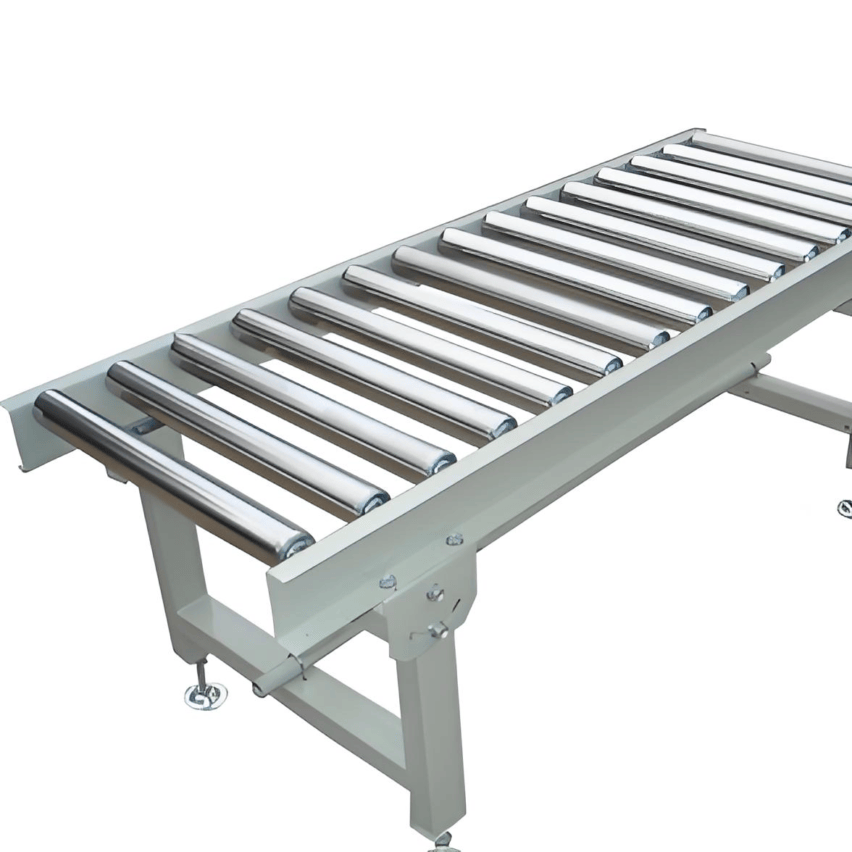Did you know? Those big and heavy cable discs in the factory, in the past, we have to rely on the workers to hum and haw to move around, not moving on the back pain is also easy to accident. But now, withAutomatic bobbin conveyor lineThe whole process is like magic - empty discs automatically on, full discs automatically down, efficiency whooshing upward! Today we will break open the crumbs to talk about, this thing in the end how to work, inside and hidden what subtle design.
🔧 I. Core principle: assembly line like building blocks
To put it bluntly, it's aHighly co-ordinated porter system. The whole process is interlocked in five steps:
- Empty discs lined up on the shelves: Empty bobbins are transported to their designated locations on a chain-plate conveyor belt (the sturdy kind with a chain) like a little train.
- A robotic pushThe cylinder (which you can think of as an air-driven actuator) goes "poof" and pushes the empty disc precisely into the slot of the receiver plate.
- Undertake to send to "recharge": The motor turns up with a chain of gears, and like a conveyor belt sends the carrier plate with the disc under the winder, waiting to be wrapped around the cable.
- A full turnaround to unload the goodsAfter wrapping, the turning mechanism (similar to a large clamp) lifts and pushes, and the full tray rolls to another conveyor frame.
- relay race: While the full trays are being transported away, the new empty trays are immediately filled in, and the assembly line does not stop for a moment.
Think about it, if this process relies on manpower, just lifting a few hundred catties of full discs would take two or three people to work, but now it's fully automated in one fell swoop, so it can't be any less time-consuming.
🛠️ II. Structural design: four "diamonds" to support automation
The skeleton of this system consists of four major modules, one without the other:
📌 1.Conveyor Duo - T-Layout Shows Its Power
- First conveyor(Main transport line): split into left and right lanes, running empty discs on the left and full discs on the right, like a two-way road.
- Second conveyor(staging area): erected horizontally above the main line to form aT-junction, responsible for feeding empty discs onto the winder and picking up full discs.
Why the T-shape? It's a good use of space! You can turn in place to change lines, saving ground and reducing knocks.
📌 2.Jacking mechanism - the smart version of the jack
Hidden under the second conveyor, the core of theCylinder + top plateCombination.
- Action Breakdown: Cylinder "hisses" upward → top plate passes through the groove of the carrier plate → lifts up the full disc → steadily falls back to the carrier plate when retracted.
Key design: top plateOne turn smaller than the slotThe threads went through tightly, like a key in a lock hole, steady and accurate.
📌 3.Flip mechanism - the clever hand that turns the bobbin over
Here comes the best part! It's hidden on the side of the conveyor frame:
- V-shaped large clamping arm: Usually shrunken and out of the way, the full plate arrives and immediately pivots;
- Cylinder push rodWhen the third cylinder fires, the V-arm "clicks" through the transmission arm, and the full disc slides like a slide to the main conveyor frame.
Subtlety: V-armsInitial height is lower than that of the carrier plateThe "Necking" is avoided by lifting it only when it is turned over.
📌 4.Driving the family bucket - the tacit cooperation of the motor gears
- Main Conveyor Belt: Motor with chain, like a bicycle chain drive, strong and durable;
- Splice plate movement: Motor-driven double gear + chain, pulling the undertaking plate slide to run, more than three times faster than manual push.
Why is it a "game changer" for factories?
Based on real-world examples, this system delivers three major direct blows:
✅Efficiency Spike 40%+: What was moving 20 trays an hour is now easily doing 35 trays;
✅Labour injury rate approaching zero: Workers never touch heavy discs again, and the risk of getting smashed is zeroed out;
✅work around the clock: People have to rest machines are not used, night shift capacity is pulled full.
Feedback from a cable factory in Suzhou says that with this set of cables, theSaving $80,000 a month in labour costsThe equipment will pay for itself in half a year - who wouldn't be tempted by such a deal?
🧩 Fourth, a personal view: automation is not to replace people, but to let people do more "intelligent" work
I have visited several factories and found an interesting phenomenon: after using fully automated bobbin threads, the workers were not laid off but transferred to theOperate screens, maintain equipment, analyse dataUp. To put it bluntly, the machine carries the heavy work, the human brain controls the overall situation - this is what the intelligent factory should look like.
But then again, this type of systemInitial investment is not smallSmall and medium-sized factories have to live within their means. But in the long run.Save labour, reduce risk, increase capacityThe triple dividend is an absolute must for manufacturing upgrades. After all, who doesn't want to make money standing up and pushing buttons?













